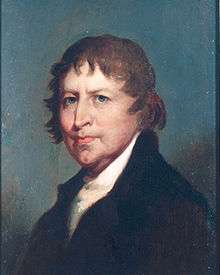Essex Junto
The Essex Junto was a powerful group of New England Federalist Party lawyers, merchants, and politicians, so named because many of the original group were from Essex County, Massachusetts. The term was coined by John Hancock in 1778 to describe the main opponents of a proposed constitution for the state of Massachusetts. The proposed constitution was rejected by the people; the state adopted its constitution in 1780. John Adams is also frequently credited with disseminating the name.[1] Over the following years the group expanded to include politicians from other New England states who were opposed to Democratic-Republican Party policies that dominated national politics.

They supported Alexander Hamilton and a group of Massachusetts radicals led by Timothy Pickering. When Hamilton was offered a place in the plot to secede New England from the Union, he denied the offer. Consequently, the Essex Junto tried to vie support from Aaron Burr, who accepted the offer from the Junto.
After Hamilton's death, they became even more extreme. During the War of 1812, they were called "Blue Lights" because of the common belief and reports from the United States Navy that they would shine blue lights to alert the British blockading ships of escaping American ships, or to alert British ships to come ashore and carry out illegal trade. They supported the Hartford Convention's disaffection with the War of 1812 and it has been claimed that they seriously proposed secession of New England, but that is not considered historically accurate.[2] Some members of the Essex Junto were Timothy Pickering, George Cabot, Fisher Ames, Francis Dana, Nathan Dane, Benjamin Goodhue, Stephen Higginson, Jonathan Jackson, John Lowell, Israel Thorndike, Nathaniel Tracy, and Theophilus Parsons.
References
- Brown, pp. 7-10
- Morison, Samuel Eliot (1968). "Our Most Unpopular War". Proceedings of the Massachusetts Historical Society. 80. pp. 38–54. ISSN 0076-4981.
[The] myth of a New England secessionist plot,… although shown to be false by every serious historian of the United States for the past 150 years, is so pleasing to people who dislike New England that many to this day continue to believe it.
- Brown, Charles The Northern Confederacy
External links
- Essex Junto, article from 1899 Cyclopaedia of Political Science
- Essex Junto, article from Encyclopædia Britannica